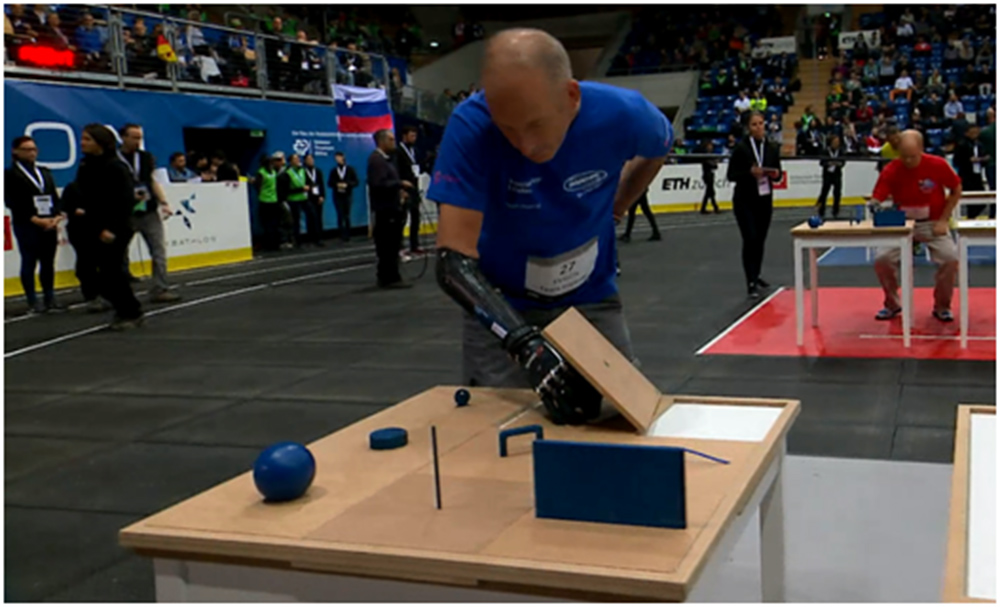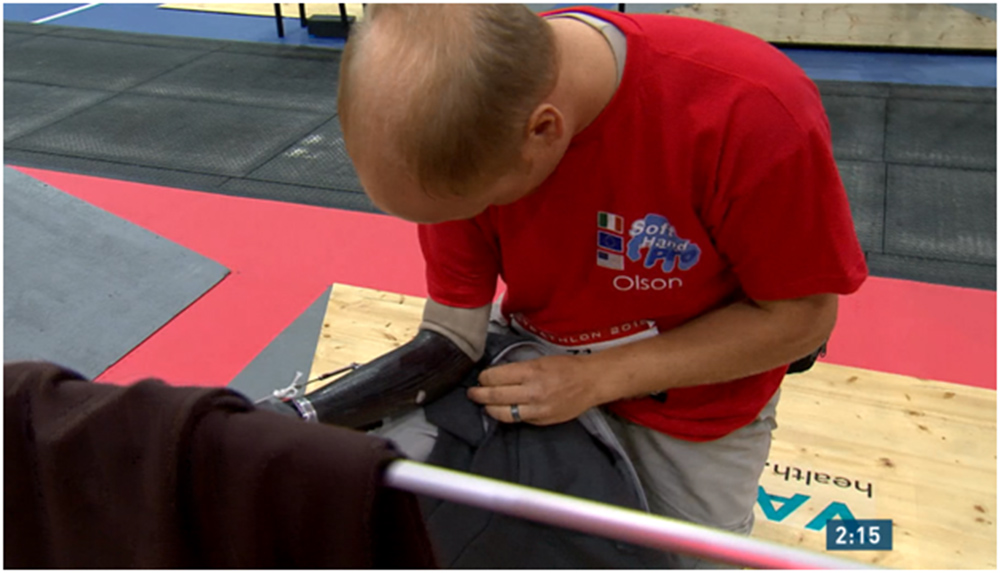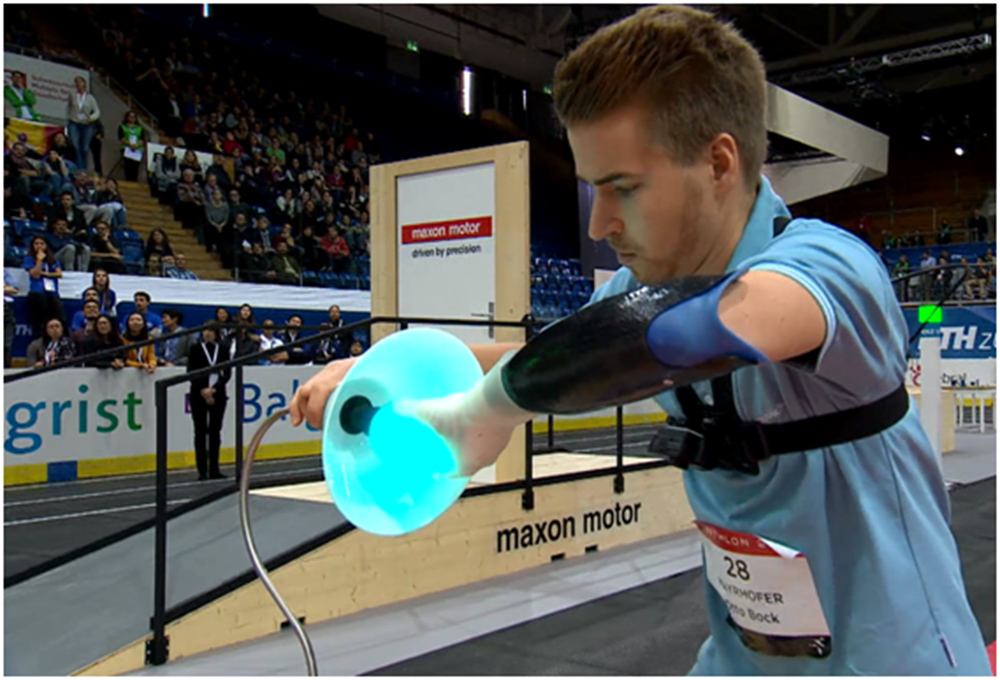Russia on the first ever cyborgs competition
This autumn in Switzerland, I took part in the Cybathlon (Eng. Cybathlon) - the first history of mankind, the competition of cyborg people. I used the Stradivary bionic prosthesis from our team “Motorika” at the competitions.
Cybathlon is another taken line of scientific and technological revolution. I am sure that we are fully aware of the fundamental importance of this event after decades, when cyborgization (of both healthy people and people with disabilities) will reach a truly fantastic level.
')
What is Cybatlon and why is it needed?
People with disabilities who use high-tech technical means of rehabilitation (TSR), as well as the developers of these same TSRs, take part in Kibatlon. Competition is the passage of obstacles in which you must perform various tasks, mainly of a domestic nature. For example, users of prosthetic hands should turn on the light bulb, and users of electric wheelchairs must overcome the ladder.
What's the point? The organizers collect all the coolest TSRs in one place and put their users in the same competitive conditions. Thanks to this, we can see with our own eyes what, for example, the prosthesis is currently the best of the existing ones. On the Cybathlon, the means of rehabilitation are compared head-on, and neither marketing tricks nor beautiful YouTube videos will help you: either your product shows the result or not. I note that both well-known transnational development companies and small startups with experimental developments can take part in Cybatlon.
Winners receive 2 medals. One goes to the development team, the second to the user (or pilot). Just like in Formula 1. In general, the first Cybathlon can be compared with the first in the history of car racing. While the results are not so fantastic, but the promise of these developments is obvious.
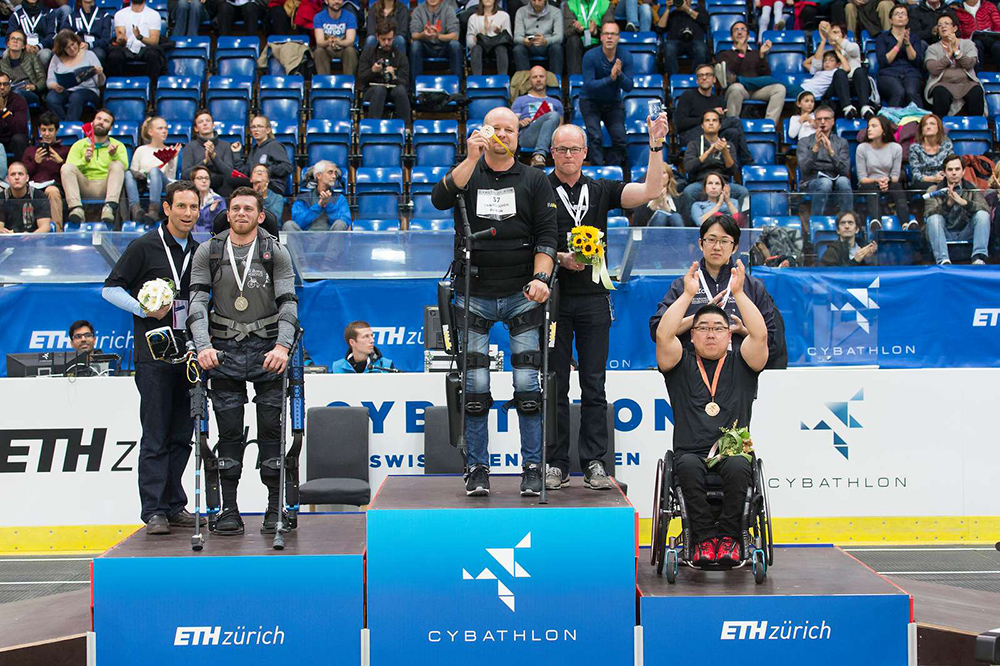
I am especially pleased that 6 teams from Russia took part in the first Cybatlon. And let the Russian teams not take prizes, I am pleased with the fact that we have high technologies in the field of rehabilitation.
The first Cybathlon was carried out in 6 disciplines: hand prostheses, leg prostheses, exoskeletons, electrocarts, neural interfaces, and functional electrical stimulation.
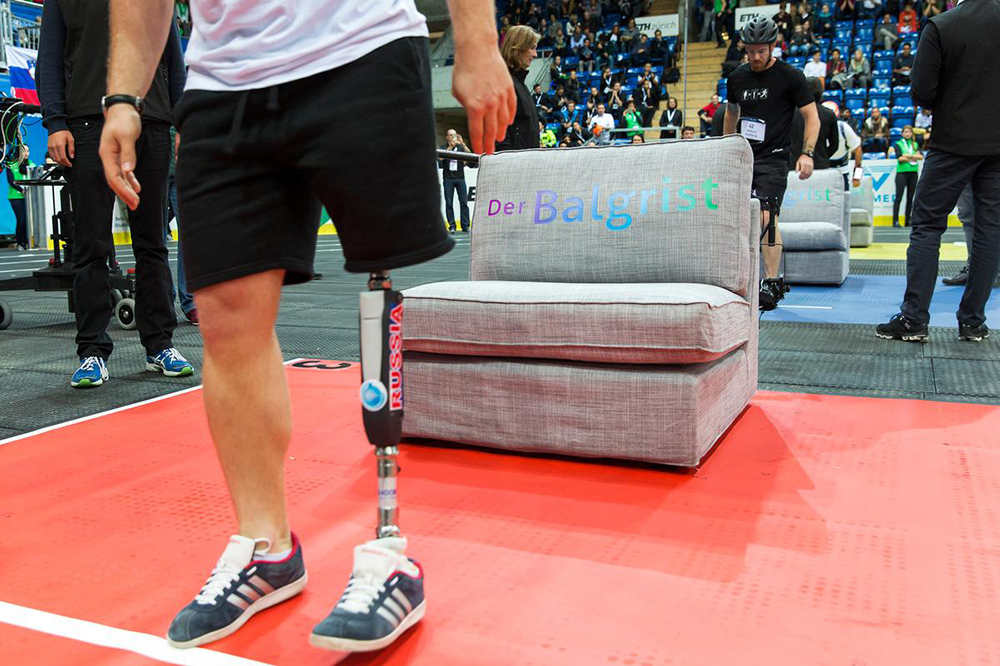
In the discipline of hip prostheses, pilots had to overcome an obstacle course imitating various life situations, for example, sit down and stand up, step over an obstacle and go up the stairs and irregularities.
12 pilots took part in the race, and four of them represented the company Ossur - one of the leading developer and long-term market leader in this segment. No wonder that it was the Ossur pilots who took the entire prize podium.
It's very cool that the fourth place was taken by the Russian development - Dmitry Ignatov with a hydraulic knee from the Ortokosmos company did not reach the top three.
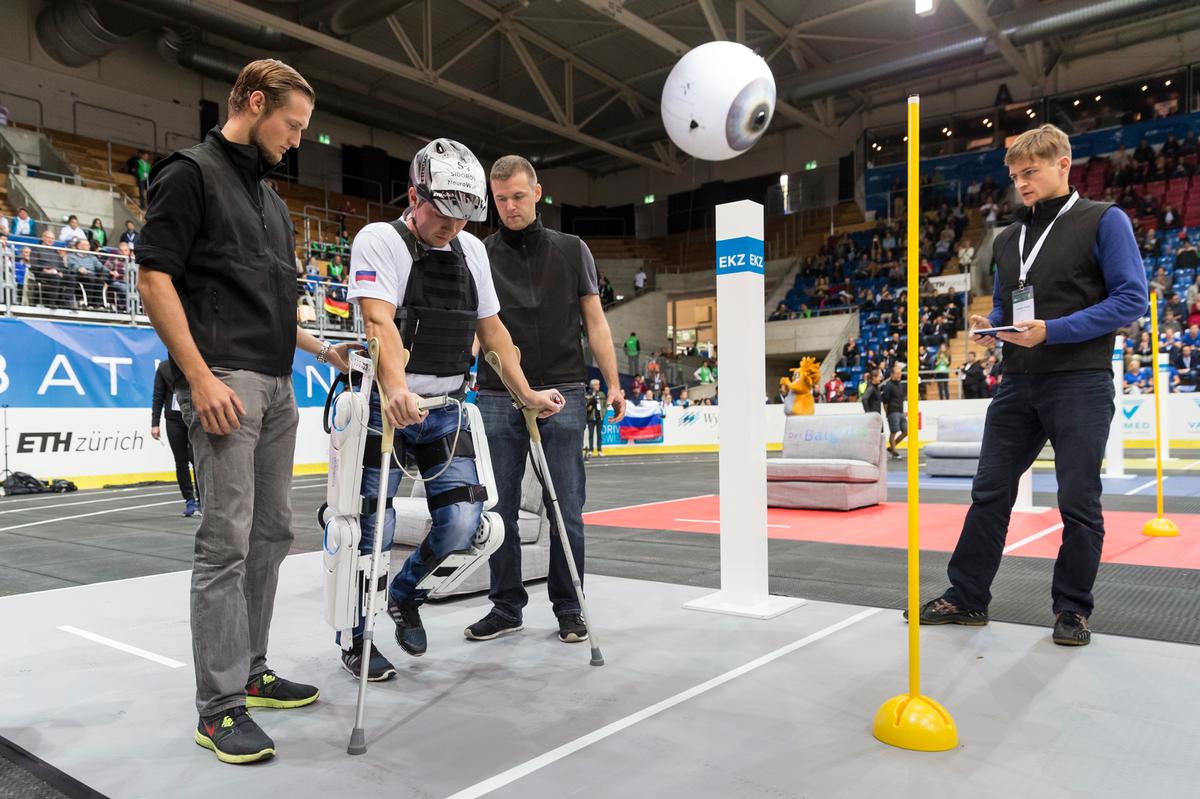
Exoskeletons make it possible for people with paralyzed lower limbs to walk. On the Cybatlon, the exoskeleton pilots had to not only walk, but maneuver between obstacles and climb ladders:
In my opinion, this is the most difficult discipline for a pilot - to move in an exoskeleton is very difficult physically. The fastest was the German exoskeleton from ReWalk. Our pilot participated in the competition with the development of the domestic company Neurobotics , but, unfortunately, he was far from the top three finalists.
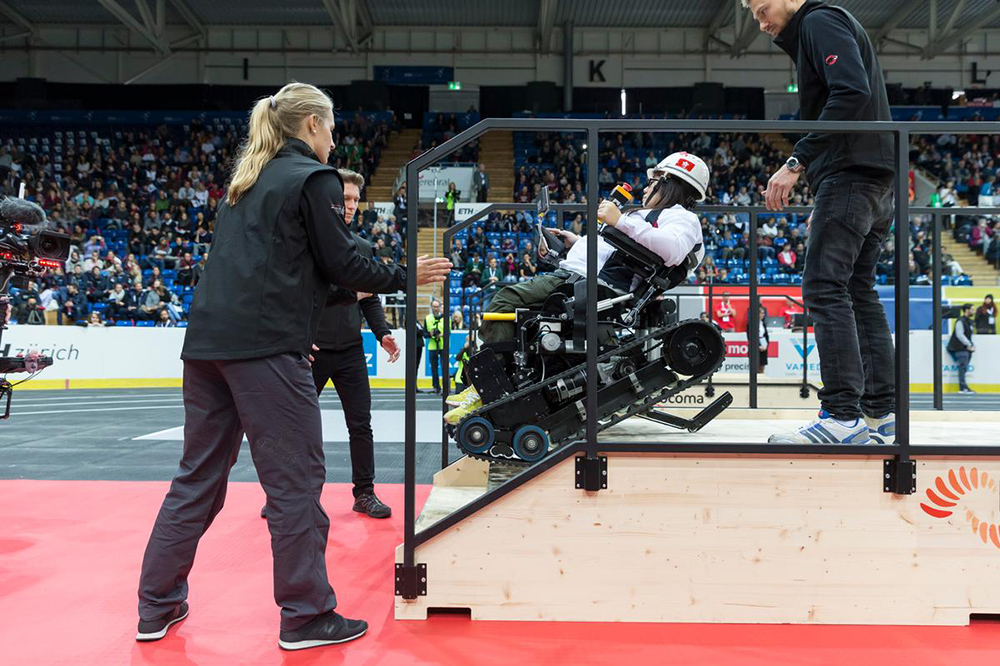
Another interesting discipline of the competition is electric wheelchair racing. Pilots overcome all the same simulated under real obstacles - artificial irregularities and inclinations, go through the "snake", enter and descend from the stairs. A detailed report on the competition in this discipline has already appeared on GeekTimes.
The discipline was attended by 12 teams from around the world, including the Novosibirsk company Caterwil. The guys have become a real discovery for me - I didn’t know that somewhere in Russia the company produces such awesome cross-country vehicles.
The most serious obstacle on the track for wheelchairs is, of course, the stairs. And the engineers of the teams solved this problem differently. For example, the Caterwil seats have both a wheeled and a crawler course. On wheels, the stroller goes fast and well maneuvers, and on the caterpillars overcomes the steps. By the way, on the track, the guys showed the highest possible result, but in the overall standings they were only in fifth place, because they lost in time. Finish first Swiss passed the track almost 2 minutes faster. How, you ask? The fact is that the Swiss designed their seat specifically for the Cybatlon. Their carriage is sharpened to overcome the steps of a specific width and height, for nothing, that the organizers prescribe all the information about the track, up to the size of the slopes and steps, in the rules.
This speaks of one of the problems of the Cybathlon - some companies tailor their TCPs specifically for the tasks of the route. On the one hand, there is nothing bad about this, because these are competitions and everyone is in the same conditions. No one bothers you to sharpen, for example, your carriage under certain steps. But after all, rehabilitation tools are designed to help people in real life, and in life all the slopes, hummocks and steps of different sizes. The guys from Caterwil came to the competition with their serial carriage, which is doubly cool.
I hope that the practice of customizing the TCP for competitions will not be justified, and in the future, the prosthesis / exoskeleton / electric wheelchair / neurointefrais will win, which will be steeper in conditions of unpredictability of the route.

Competition among partially paralyzed users of neural interfaces “Brain-computer”. The technology allows you to process electrical signals from the cerebral cortex, amplify and transfer them to a computer, and then using the processing algorithms to produce synchronization with the device or application. The competition is the passage of a computer arcade , the actions of the protagonist of which the pilot controls using the “power of thought”. In total, the user gives 4 commands - jump, tackle, step and jerk. Each team corresponded to a specific trailer, on which the virtual player moved.
The first 2 places in the race were taken by the Swiss from the Brain Tweakers. Russia on the Cybathlon was represented by another development of the company Neurobotics. Domestic neuroperface recognizes up to 8 separate commands in real time, works from just 8 monopolar electrodes.
Participate as a pilot in the competition can only pilots with neck injuries, as our team was notified shortly before the Cybathlon. Because of this, a suitable pilot was found only 3 days before departure to Switzerland. But the problems did not end there either. Here is what the guys themselves say:

The competition is a bicycle race in which pilots with spinal cord injury participate. Electrical muscle stimulation allows users to pedal bicycles. This is the only discipline in which domestic developments have not been presented, but I heard that similar studies are being conducted in Russia.
First place by Team Cleveland by a large margin
Hand prostheses:
Users of prosthetic hands competed in performing various household actions - move objects of various weights and shapes, screw in a light bulb, fasten buttons and a zipper. A separate section was devoted to the preparation of breakfast: it was necessary to open a tin can, cut off a piece of bread, etc. From myself I will say that the tasks on the track were made up wisely, all these daily activities are really not easy to perform using a prosthesis.
At the competition we saw a lot of unusual prostheses. For example, a completely crazy hand from the Japanese:
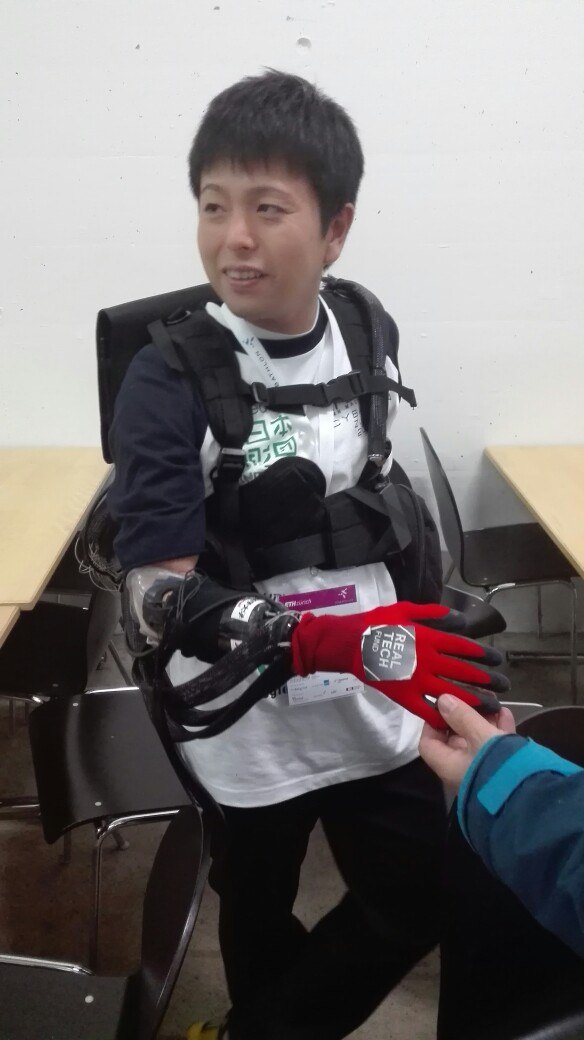

3rd place was taken by osteointegrated (implanted) prosthesis. In fact, this is a common bioelectric prosthesis from Otto Bock, but the control signals are read implanted, not surface electrodes:
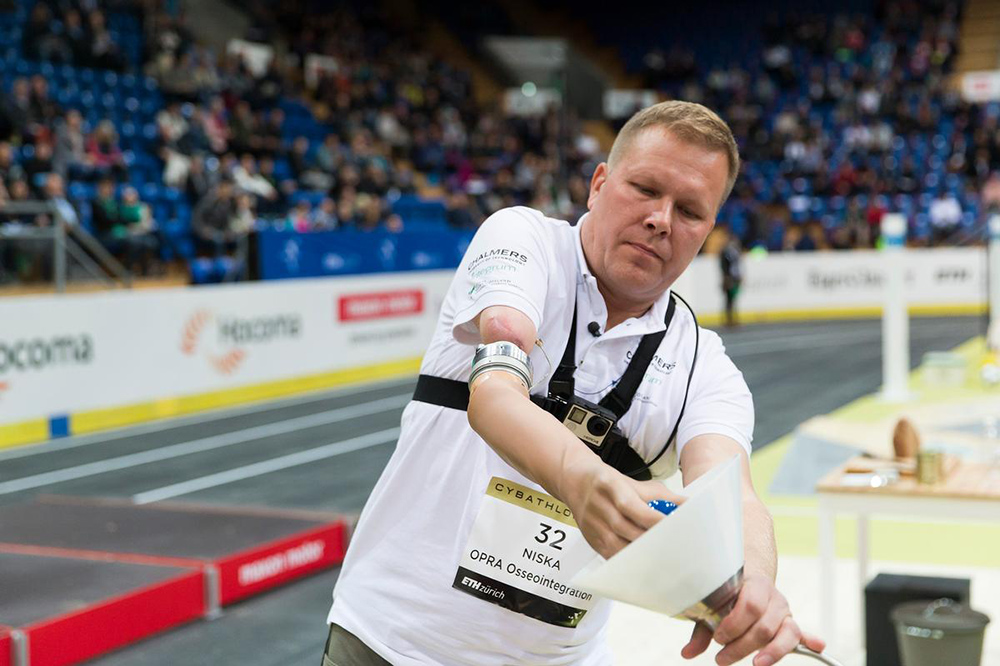
As I wrote at the beginning, any company with any prosthesis, including non-high-tech, can take part in the Cybathlon. And so it happened that a traction prosthetic hook was victorious in this discipline.
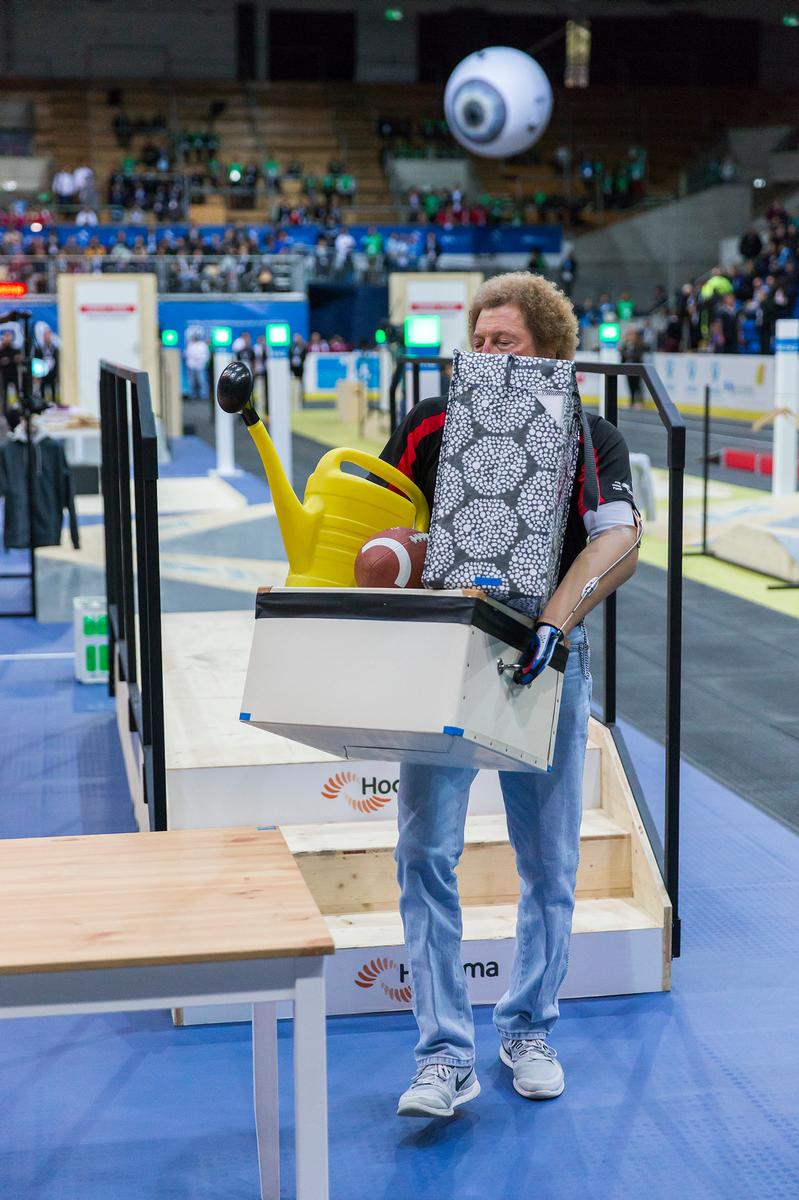
Yes, the technology of the 19th century was the best of all expensive bionic hands a la terminator. And this is a serious reason for reflection. This is what Ilya Chekh, the director of Motorika, thinks about this:
In the competition of bionic hands, 12 teams were declared, including 2 of our companies - Kleiber Bionix (with Kleiber Solo prosthesis) and Motorika (with Stradivary prosthesis). But for technical reasons, only 10 teams took to the start. Cybathlon is a technology competition, and technology tends to refuse. At Kibatlon we witnessed problems with functional electrostimulation, failures of electric wheelchairs and exoskeletons. Unfortunately, this fate has not passed and domestic companies. This is how Ivan Krechetov, the head of Klayber, describes what happened:
The history of the kibatlon version of the Stradivary prosthesis also begins in the late summer of 2016, when it was decided to change the “5 fingers - 5 drives” system (à la Bebionic) with a 3-wheel brush (1 drive per thumb, 1 - with index and middle fingers). another 1 - on the nameless and pinky). Software management Stradivary developed Moscow company Bitronicslab
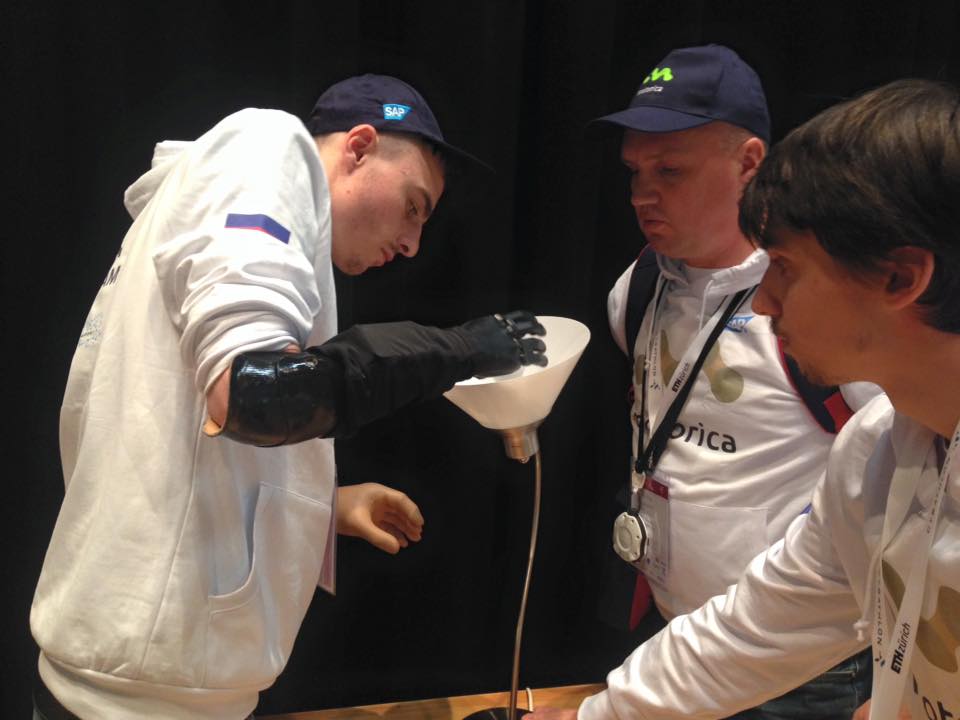
In early September, the necessary engines were ordered from Canada, but due to an error in the documents and the subsequent monstrous bureaucratic red tape, the drives were stuck at customs in Vnukovo for almost 2 months. Therefore, suitable drives were bought by us in Munich just one day before the competition. Naturally, there was absolutely no time for testing and practicing, and as a result, the failure of the prosthesis and on the track I managed to perform only one task out of six:
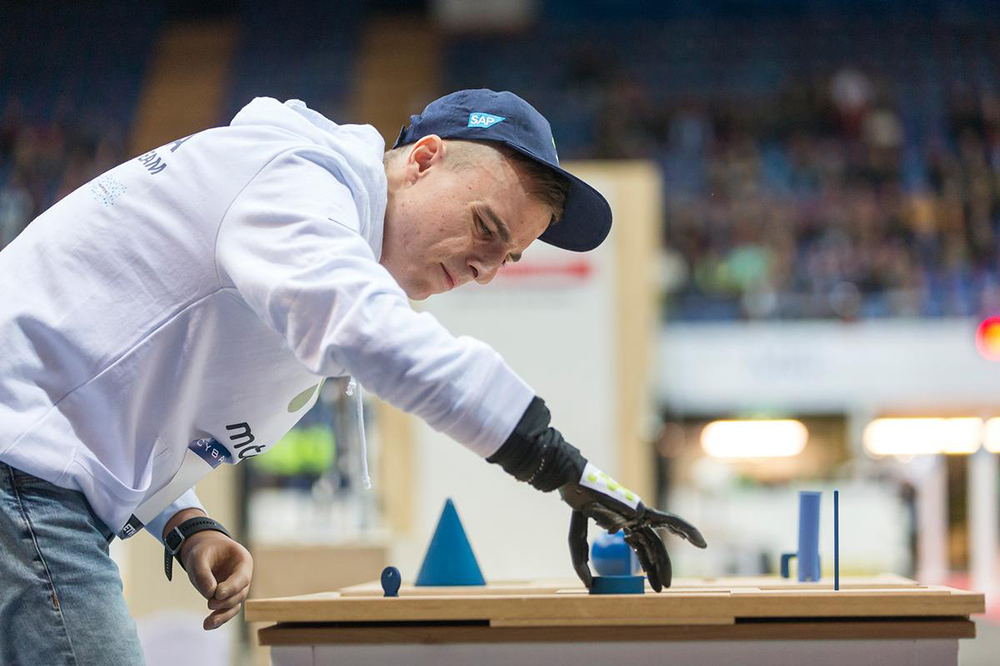

Of course, we expected a better result, but we are not upset - our rivals were the largest companies that invest millions of dollars in their development. Someday we will be able to make them a serious competition.
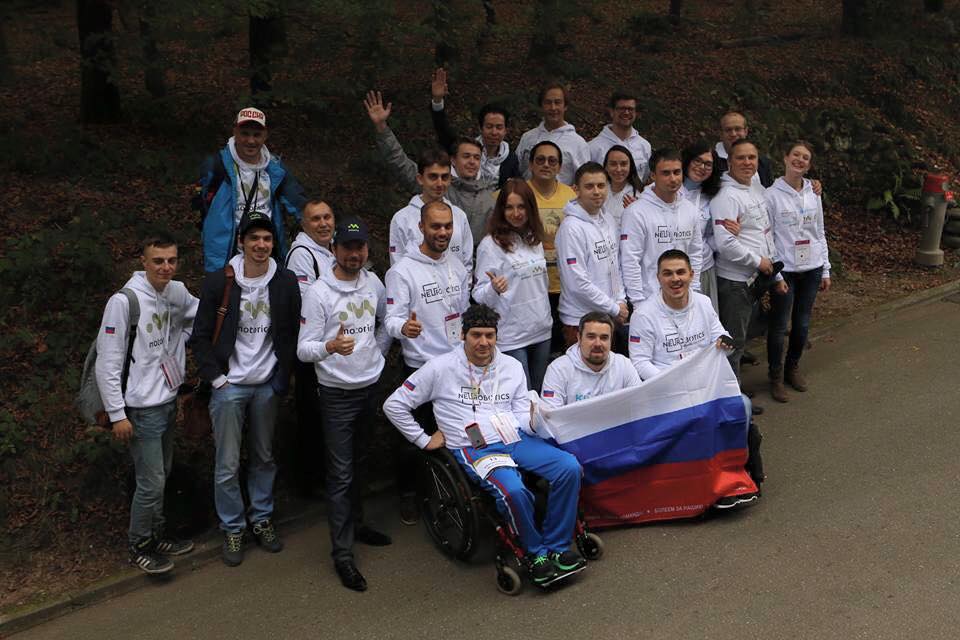
Competition in Russia. Kibatletika
Now we have an idea to hold such competitions in Russia. In August we already held a mini-competition at the Exhibition of Economic Achievements :

By the way, we took the winner of these competitions with us to Zurich on Kibatlon.
In 2017, we plan to organize a truly major event. Our competitions will be available to a large number of people with disabilities (including children). And the more developers take part in them, the better (and ultimately more affordable) rehabilitation tools will be for Russian users. I urge all engineers and developers, as well as users of various TCP, to join this initiative. In this regard, the survey:
Cybathlon is another taken line of scientific and technological revolution. I am sure that we are fully aware of the fundamental importance of this event after decades, when cyborgization (of both healthy people and people with disabilities) will reach a truly fantastic level.
')
What is Cybatlon and why is it needed?
People with disabilities who use high-tech technical means of rehabilitation (TSR), as well as the developers of these same TSRs, take part in Kibatlon. Competition is the passage of obstacles in which you must perform various tasks, mainly of a domestic nature. For example, users of prosthetic hands should turn on the light bulb, and users of electric wheelchairs must overcome the ladder.
What's the point? The organizers collect all the coolest TSRs in one place and put their users in the same competitive conditions. Thanks to this, we can see with our own eyes what, for example, the prosthesis is currently the best of the existing ones. On the Cybathlon, the means of rehabilitation are compared head-on, and neither marketing tricks nor beautiful YouTube videos will help you: either your product shows the result or not. I note that both well-known transnational development companies and small startups with experimental developments can take part in Cybatlon.
Winners receive 2 medals. One goes to the development team, the second to the user (or pilot). Just like in Formula 1. In general, the first Cybathlon can be compared with the first in the history of car racing. While the results are not so fantastic, but the promise of these developments is obvious.

I am especially pleased that 6 teams from Russia took part in the first Cybatlon. And let the Russian teams not take prizes, I am pleased with the fact that we have high technologies in the field of rehabilitation.
The first Cybathlon was carried out in 6 disciplines: hand prostheses, leg prostheses, exoskeletons, electrocarts, neural interfaces, and functional electrical stimulation.
Prosthetic leg

In the discipline of hip prostheses, pilots had to overcome an obstacle course imitating various life situations, for example, sit down and stand up, step over an obstacle and go up the stairs and irregularities.
12 pilots took part in the race, and four of them represented the company Ossur - one of the leading developer and long-term market leader in this segment. No wonder that it was the Ossur pilots who took the entire prize podium.
It's very cool that the fourth place was taken by the Russian development - Dmitry Ignatov with a hydraulic knee from the Ortokosmos company did not reach the top three.
Exoskeletons

Exoskeletons make it possible for people with paralyzed lower limbs to walk. On the Cybatlon, the exoskeleton pilots had to not only walk, but maneuver between obstacles and climb ladders:
In my opinion, this is the most difficult discipline for a pilot - to move in an exoskeleton is very difficult physically. The fastest was the German exoskeleton from ReWalk. Our pilot participated in the competition with the development of the domestic company Neurobotics , but, unfortunately, he was far from the top three finalists.
Electro-electrician

Another interesting discipline of the competition is electric wheelchair racing. Pilots overcome all the same simulated under real obstacles - artificial irregularities and inclinations, go through the "snake", enter and descend from the stairs. A detailed report on the competition in this discipline has already appeared on GeekTimes.
The discipline was attended by 12 teams from around the world, including the Novosibirsk company Caterwil. The guys have become a real discovery for me - I didn’t know that somewhere in Russia the company produces such awesome cross-country vehicles.
The most serious obstacle on the track for wheelchairs is, of course, the stairs. And the engineers of the teams solved this problem differently. For example, the Caterwil seats have both a wheeled and a crawler course. On wheels, the stroller goes fast and well maneuvers, and on the caterpillars overcomes the steps. By the way, on the track, the guys showed the highest possible result, but in the overall standings they were only in fifth place, because they lost in time. Finish first Swiss passed the track almost 2 minutes faster. How, you ask? The fact is that the Swiss designed their seat specifically for the Cybatlon. Their carriage is sharpened to overcome the steps of a specific width and height, for nothing, that the organizers prescribe all the information about the track, up to the size of the slopes and steps, in the rules.
This speaks of one of the problems of the Cybathlon - some companies tailor their TCPs specifically for the tasks of the route. On the one hand, there is nothing bad about this, because these are competitions and everyone is in the same conditions. No one bothers you to sharpen, for example, your carriage under certain steps. But after all, rehabilitation tools are designed to help people in real life, and in life all the slopes, hummocks and steps of different sizes. The guys from Caterwil came to the competition with their serial carriage, which is doubly cool.
I hope that the practice of customizing the TCP for competitions will not be justified, and in the future, the prosthesis / exoskeleton / electric wheelchair / neurointefrais will win, which will be steeper in conditions of unpredictability of the route.
Neurointerfaces (BCI - Brain – computer interface)

Competition among partially paralyzed users of neural interfaces “Brain-computer”. The technology allows you to process electrical signals from the cerebral cortex, amplify and transfer them to a computer, and then using the processing algorithms to produce synchronization with the device or application. The competition is the passage of a computer arcade , the actions of the protagonist of which the pilot controls using the “power of thought”. In total, the user gives 4 commands - jump, tackle, step and jerk. Each team corresponded to a specific trailer, on which the virtual player moved.
The first 2 places in the race were taken by the Swiss from the Brain Tweakers. Russia on the Cybathlon was represented by another development of the company Neurobotics. Domestic neuroperface recognizes up to 8 separate commands in real time, works from just 8 monopolar electrodes.
Participate as a pilot in the competition can only pilots with neck injuries, as our team was notified shortly before the Cybathlon. Because of this, a suitable pilot was found only 3 days before departure to Switzerland. But the problems did not end there either. Here is what the guys themselves say:
The problems started at the competitions themselves when we entered the BCI zone. Alas, but the organizers, who so meticulously demanded various documents and certificates, could not organize a place for the discipline. Elementary protection against electromagnetic interference was not, and it is simply necessary for electroencephalography. When the device was connected, data packets were lost and information transfer was delayed, it didn’t look very nice and as a result, we showed a bad time (162 seconds) in qualifying, despite the fact that we passed the course for an average of 115 seconds in training.
It was a little insulting and annoying for such a flaw and flaw, because we have fairly good software for working with the neurocomputer interface, and at least we counted on the top place. In the overall standings, we were on the 7th line and now we were fighting for 5-8 places. And then luck helped us: rejecting a little monitor on the laptop, the signal became a little better and as a result we won in our group with a score of 131 seconds and took 5th place in the BCI competition. But according to the results of two final groups for 1-4 and 5-8 places, we showed 2 time, losing only 5 seconds to the winner from the group of finalists.
In general, the competition for the neurocomputer interface were the most inappropriate conditions. Problems with noise and noise were all, even those who used wired interfaces (ours is 8-channel wireless). We hope that next time the organizers of Cybathlon will take into account the peculiarities of the removal of the EEG.
For ourselves from the competition, we made the following conclusions:
- We can. We are not far behind our foreign colleagues.
- Next year we will try to make all the preparations in advance.
- Neurocomputer interface should be protected from extraneous interference.
- Switzerland is cute
Functional electrical stimulation

The competition is a bicycle race in which pilots with spinal cord injury participate. Electrical muscle stimulation allows users to pedal bicycles. This is the only discipline in which domestic developments have not been presented, but I heard that similar studies are being conducted in Russia.
First place by Team Cleveland by a large margin
Hand prostheses:
Users of prosthetic hands competed in performing various household actions - move objects of various weights and shapes, screw in a light bulb, fasten buttons and a zipper. A separate section was devoted to the preparation of breakfast: it was necessary to open a tin can, cut off a piece of bread, etc. From myself I will say that the tasks on the track were made up wisely, all these daily activities are really not easy to perform using a prosthesis.
At the competition we saw a lot of unusual prostheses. For example, a completely crazy hand from the Japanese:


3rd place was taken by osteointegrated (implanted) prosthesis. In fact, this is a common bioelectric prosthesis from Otto Bock, but the control signals are read implanted, not surface electrodes:

As I wrote at the beginning, any company with any prosthesis, including non-high-tech, can take part in the Cybathlon. And so it happened that a traction prosthetic hook was victorious in this discipline.

Yes, the technology of the 19th century was the best of all expensive bionic hands a la terminator. And this is a serious reason for reflection. This is what Ilya Chekh, the director of Motorika, thinks about this:
1. The winner of the discipline was the traction prosthesis hook, which performs one grip due to movement in the shoulder joints (similar to Rudenko’s traction prostheses, common in Russia). The advantages of the prosthesis are high reliability, strong grip, the presence of muscular “feedback”, i.e. the person feels how strongly the prosthesis compresses, intuitively regulates the speed of the grip, and also more accurately controls the position of the hand in space. The disadvantage of the traction hook is the absence of a swivel wrist, which, when performing complex spatial manipulations, has to perform a compensatory movement of the shoulder and body:
2. None of the prostheses presented on the Cybathlon, except for the traction hook, could lift a heavy, complex and smooth shape in the usual way (aluminum cone in the first test, weight - 2.5 kg). To accomplish this task, users had to first turn the object, and then pick it up with a thickening.
This suggests that bioelectric prostheses do not develop enough force to hold smooth heavy objects.
3. The most difficult elements of some tasks were performed only with a healthy hand. For example, buttoning and zippers, opening a tin can, cutting bread. In the last test (carrying things), prostheses of almost all teams were either not used in principle, or were used solely as a counter-seal (as a cosmetic prosthesis would have coped with):
4. The test with the curl of the lampchik was the fastest to pass the prosthesis of Michelangelo, the German company Otto Bock (2nd place according to the results of the competition), thanks to an electric wrist rotator. The rest of the teams had to simply put a light bulb on the base and then twist it with one finger or the entire prosthesis as a static tool. What took much more time:
5. According to the results of the competition, it is worth noting another feature: all prostheses with individual finger drives took the last places. As noted above, the first place was taken by the traction hook, the second place was the multifunctional Michelangelo prosthesis (with 2 engines and a “gearbox” for different grip), the third place was a low-function prosthesis from OttoBock, which performs one grip.
In the competition of bionic hands, 12 teams were declared, including 2 of our companies - Kleiber Bionix (with Kleiber Solo prosthesis) and Motorika (with Stradivary prosthesis). But for technical reasons, only 10 teams took to the start. Cybathlon is a technology competition, and technology tends to refuse. At Kibatlon we witnessed problems with functional electrostimulation, failures of electric wheelchairs and exoskeletons. Unfortunately, this fate has not passed and domestic companies. This is how Ivan Krechetov, the head of Klayber, describes what happened:
For technical reasons, our team (LLC “Cliber Bionix”) had to withdraw from the competition.
We should start with our preliminary preparation. The summer version of the Kleiber Solo prosthesis possessed the following characteristics (full compression time 0.24 (!) S, developed effort at the fingertip ~ 200 g; the prosthesis was too fast and, accordingly, weak). In addition, in the Rev A. motherboard version, an error was detected at the operating point of the power transistors, due to which the maximum current was only 0.8A with actually possible 1.8A, which, among other things, caused overheating. Participation with this version in comparison with world leaders (compression for 1.0 seconds with an effort at the tip of the finger to 1.5 kg) would be a failure and at the end of August we continued to develop. It was expected that the moment would increase 8 (!) Times (4 times the deceleration of the gearbox, 2 times the current to the motors). At the end of September, a new version was assembled, Rev B boards were put into production, which was delayed for 11 working days and we did not have time to get them before leaving for Zurich.
Here we decided to go for broke, realizing that in Rev A. transistors can burn from overheating, which, in fact, happened during testing and debugging. We take a mobile version of the laboratory with us (soldering stations, circuit boards, electronic components and much more) to responsible events, but, unfortunately, when soldering wires for Hall sensors, we used washable flux (there was nothing to wash it with) and With an endless chain of short circuits, they did not have time to solder the working set, as they informed the organizers that we were shooting at the stage of passing the technical regulations.
Initially, we pursued ambitious goals to speak no worse than market leaders, to declare ourselves. But after analyzing the circumstances, a puzzle of cause-and-effect relationships developed in the head, a pleasant sensation appeared - the ability to take responsibility for one’s actions. This was only one of the possibilities, but not the last one for us. By the way, our idea was a success, the current (Rev B.) version already gives out 1.35 kg on the fingertip at 0.95 seconds for full compression. We are working on a pre-production Rev D. (we decided not to waste time and updated the production of Rev C.).
The history of the kibatlon version of the Stradivary prosthesis also begins in the late summer of 2016, when it was decided to change the “5 fingers - 5 drives” system (à la Bebionic) with a 3-wheel brush (1 drive per thumb, 1 - with index and middle fingers). another 1 - on the nameless and pinky). Software management Stradivary developed Moscow company Bitronicslab

In early September, the necessary engines were ordered from Canada, but due to an error in the documents and the subsequent monstrous bureaucratic red tape, the drives were stuck at customs in Vnukovo for almost 2 months. Therefore, suitable drives were bought by us in Munich just one day before the competition. Naturally, there was absolutely no time for testing and practicing, and as a result, the failure of the prosthesis and on the track I managed to perform only one task out of six:


Of course, we expected a better result, but we are not upset - our rivals were the largest companies that invest millions of dollars in their development. Someday we will be able to make them a serious competition.

Competition in Russia. Kibatletika
Now we have an idea to hold such competitions in Russia. In August we already held a mini-competition at the Exhibition of Economic Achievements :

By the way, we took the winner of these competitions with us to Zurich on Kibatlon.
In 2017, we plan to organize a truly major event. Our competitions will be available to a large number of people with disabilities (including children). And the more developers take part in them, the better (and ultimately more affordable) rehabilitation tools will be for Russian users. I urge all engineers and developers, as well as users of various TCP, to join this initiative. In this regard, the survey:
Source: https://habr.com/ru/post/400343/
All Articles

